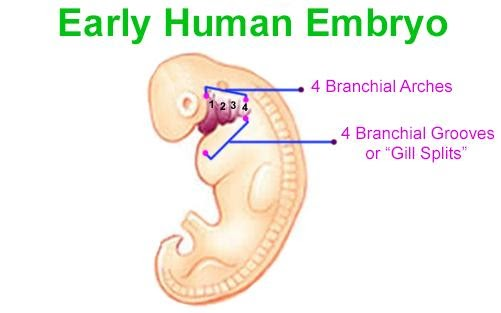
Answer
375.6k+ views
Hint: Human embryonic development or human embryogenesis refers to the development and formation of the human embryo. In sexually reproducing organisms, embryonic development begins just after fertilization and continues through the formation of body structures, such as tissues and organs.
Complete Answer:
Each embryo starts its development as a zygote which is a single cell resulting from the fusion of gametes. In the first stages of embryonic development, a single-celled zygote undergoes several rapid cell divisions, called cleavage and forms a blastula. Next, the cells in a blastula-stage embryo start rearranging themselves into layers. That process is called gastrulation. These layers each give rise to different parts of the developing multicellular organism, such as the nervous system, connective tissue and organs. Early human embryo possesses a dorsal hollow nerve cord, a well-developed notochord and a series of gill slits to sustain itself in the environment of the womb. These slits are found in embryos of all vertebrates because they share the common ancestry of fish in which these structures first evolved. In humans, they disappear before birth.
Note:
Between the head and the heart, a series of branchial arches, i.e., cartilaginous structures supporting the gills of fishes and larval amphibians, begin to form. In higher vertebrates, these structures form part of the jaw and the ear.

Figure: Gill slits in an embryo
Complete Answer:
Each embryo starts its development as a zygote which is a single cell resulting from the fusion of gametes. In the first stages of embryonic development, a single-celled zygote undergoes several rapid cell divisions, called cleavage and forms a blastula. Next, the cells in a blastula-stage embryo start rearranging themselves into layers. That process is called gastrulation. These layers each give rise to different parts of the developing multicellular organism, such as the nervous system, connective tissue and organs. Early human embryo possesses a dorsal hollow nerve cord, a well-developed notochord and a series of gill slits to sustain itself in the environment of the womb. These slits are found in embryos of all vertebrates because they share the common ancestry of fish in which these structures first evolved. In humans, they disappear before birth.
Note:
Between the head and the heart, a series of branchial arches, i.e., cartilaginous structures supporting the gills of fishes and larval amphibians, begin to form. In higher vertebrates, these structures form part of the jaw and the ear.

Figure: Gill slits in an embryo
Recently Updated Pages
How many sigma and pi bonds are present in HCequiv class 11 chemistry CBSE

Mark and label the given geoinformation on the outline class 11 social science CBSE

When people say No pun intended what does that mea class 8 english CBSE

Name the states which share their boundary with Indias class 9 social science CBSE

Give an account of the Northern Plains of India class 9 social science CBSE

Change the following sentences into negative and interrogative class 10 english CBSE

Trending doubts
Fill the blanks with the suitable prepositions 1 The class 9 english CBSE

The Equation xxx + 2 is Satisfied when x is Equal to Class 10 Maths

In Indian rupees 1 trillion is equal to how many c class 8 maths CBSE

Which are the Top 10 Largest Countries of the World?

How do you graph the function fx 4x class 9 maths CBSE

Give 10 examples for herbs , shrubs , climbers , creepers

Difference Between Plant Cell and Animal Cell

Difference between Prokaryotic cell and Eukaryotic class 11 biology CBSE

Why is there a time difference of about 5 hours between class 10 social science CBSE



